Clinical Study on the Anti-Aging Effect of A Cream Containing Ginseng Root Extract and L-Carnosine
Sun Hongmei, Dai Jieling, Yang Qiongli, Li Yingyi, Liu Fengsong
Infinitus China Co. Ltd., China
Abstract The anti-aging effects of a cream containing L-carnosine and ginseng root extract to provide a reference for the evaluation and development of anti-aging cosmetics were tested. Sixty healthy females, aged 35~60,were grouped into test sample and placebo groups. Skin elasticity, gloss, and wrinkles of the participants were analyzed before use and after use for 8 weeks. Instrument measurement results showed that after 8 weeks,skin elasticity, gloss, and wrinkles in the members of the test sample group obviously improved relative to those of the placebo group. Clinical effect assessment results showed that subjects did not experience adverse skin reactions, and their skin gloss showed obvious improvement. Self-assessment results showed that 87%subjects are satisfied with the test sample. Cream containing L-carnosine and ginseng root extract has a certain anti-aging effect.
Key words ginseng root extract; L-Carnosine; anti-aging; clinical study
Introduction
Consumers often prefer anti-aging cosmetics made from herbal extracts,[1-3]and many evaluation methods for determining the anti-aging effects of cosmetics have been used.[4-5]Zhao Dan et al.[6]measured the free radical scavenging ability of Ganoderma broth and confirmed that it has a certain anti-aging effect. Gao yaqian et al.[7]used an instrumental method combined with image analysis to evaluate the fineness of skin around the eyes and confirmed that eye cream containing green tea extract has an anti-aging effect. Li Zan et al.[8]measured the skin moisture and water loss using the instrument method, evaluated skin wrinkles using image analysis and volunteer questionnaires, and confirmed that ginseng products have an anti-aging effect.
Ginsenosides are the main active components of ginseng root, which promote anti-aging processes by increasing antioxidant enzyme activity, inducing the expression of SOD and CAT genes, and reducing LPO and MDA content. Ginsenosides can also affect the regulation of the cell cycle and aging gene expression and prolong the telomere and increase its activity through immune system regulation at the molecular and cellular levels,thereby slowing down aging.[9]L-carnosine is a dipeptide composed of two amino acids β-alanine and L-histidine.It is a natural antioxidant found in the muscles and brain of animals. Several studies showed that L-histidine has an anti-aging effect because it protects DNA and proteins.[10]L-histidine and isoalanine have great application value in the field of personal care. However, their combined use in anti-aging cosmetics has not been reported yet.
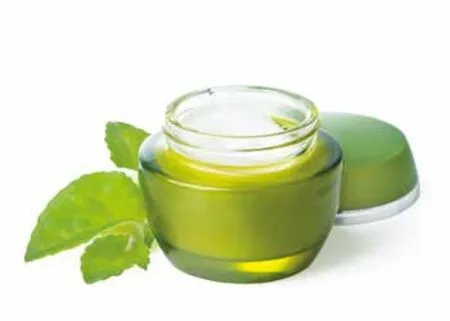
In this study, the anti-aging effect of a cream containing ginseng root extract and L-carnosine was studied. The results can provide a reference for developing anti-aging cosmetics.
Test method
Materials
The test sample and placebo were provided by Infinitus (China) Co., Ltd. Water, butylene glycol,glycerin, isononyl isononanoate, polyglyceryl-3 methylglucose distearate, glyceryl stearate, PEG-100 stearate, cetearyl alcohol, Panax ginseng root extract,carnosine, and xanthan gum were the main components of the test sample. The placebo was mainly composed of water, butylene glycol, glycerin, isononyl isononanoate,polyglyceryl-3 methylglucose distearate, glyceryl stearate,PEG-100 stearate, cetearyl alcohol, and xanthan gum, and it had a basic moisturizing effect.
Subjects
A total of 60 healthy females, aged 35—60, were divided into the test sample group and placebo group.The subjects were assessed according to the seven-grade system of the Skin Aging Atlas Volume 2 Asian Type page 41,[11]where a score of 1 corresponds to don’t reflect light of the skin, very dark and a score of 9 corresponds to light skin and healthy gloss. Subjects have obvious fine lines on the crow’s feet and lack of elasticity and gloss on the face(visual inspection: ≤4), and skin wrinkle on the crow’s feet (visual inspection: ≥4).
Test Procedure
We performed a double-blind test, where the first group used test sample and the other used placebo. The subjects applied appropriate amount of sample on the face in the morning and evening. The subjects cleaned their face at D0,filled in the informed consent, and rested for 15 minutes in the laboratory with temperature of 21℃ ± 1℃ and relative humidity of 50% ± 5%. The dermatologist evaluated the skin condition of the subjects. Visia CR and Primos were used to take images. Then, skin elasticity, gloss, and wrinkles were evaluated. The subjects applied the product according to the instructions and returned to the lab at D28 and D56 for the measure as D0 and self-assessment of their skin conditions.
Methods
(1) Skin elasticity
Skin elasticity parameter R2 was detected by using Cutometer MPA580 (CK company, Germany) in an average of three measurements. R2 value refers to the ratio between the amount of skin rebound when no negative pressure is present, and the maximum amount of stretching when negative pressure is present. The closer R2 value is to 1, the more elastic the skin is.
(2) Skin gloss
Skin gloss was detected with Glossymeter GL200 (CK company, Germany) in an average of three measurements.The higher the test value, the better the skin gloss.
Another parameter is total light rate. First, facial images were collected with Visia CR (Canfield company,America), which were analyzed with Image-Pro Plus. The total light rate was obtained by calculating the average brightness value. The higher the test value, the better the skin gloss.
(3) Skin wrinkle
Skin wrinkle parameter Sa was detected with Primos(GFM company, Germany) in an average of three measurements. The Sa value represents the depth of the wrinkles. The lower the Sa value, the lesser skin wrinkles.
(4) Clinical evaluation
The safety and efficacy of the sample were evaluated by a dermatologist. The cutaneous adverse reaction(erythema, edema, decrustation, rash, tight, pruritus, and stabbing pain) was evaluated at pretreatment and after 4 and 8 weeks of application. The evaluation standard was 0~9. A score of 0 corresponds to the absence of rashes or subjective feeling, 1~2 to slight rash or subjective feeling,3~4 to light rash or subjective feeling, 5~6 to mean median rash or subjective feeling, 7~8 to mean serious rash or subjective feeling, and 9 to very serious rash or subjective feeling.
The gloss and elasticity of the face were evaluated by using the following scores: for the skin gloss, 1 corresponds to don’t reflect light of the skin, very dark;9 reflects light highly of the skin, healthy gloss. For skin elasticity, score 1 corresponds to inelastic skin and 9 corresponds to very elastic skin.
(5) Self-assessment
The subjects filled out a self-evaluation questionnaire after 4 and 8 weeks. The assessment standard was based on scores of 5, 4, 3, 2, and 1, which correspond to very satisfied, satisfied, general, dissatisfied, and very dissatisfied, respectively.
Statistical analysis
Data were analyzed with SPSS 19.0. The data between before and after application were compared using a paired t-test, and the significant level p value<0.05.
Results
Skin elasticity
Figure 1a presents the measurement value of skin elasticity R2 of the cheek at different times, showing that the R2 value of the test sample increased significantly(p<0.05). The R2 value of the placebo was reduced significantly (p<0.05) after 8 weeks. The results showed that skin elasticity increased when the test sample was used, whereas skin elasticity in the placebo group decreased with time because the basic moisturizing effect was not obvious enough and skin elasticity is usually decreases by age and environmental factors.

Figure 1a. Skin elasticity R2 value (*p<0.05)
Figure 1b presents the changes in the skin elasticity value R2 of the cheek at different times. A significant difference between the R2 values of the test sample and the placebo was observed after 8 weeks (p<0.05). The value of the test sample increased more than that of the placebo in both cases. The test sample had certain effects on improving skin elasticity compared with using placebo, and this improvement will be more obvious over time.
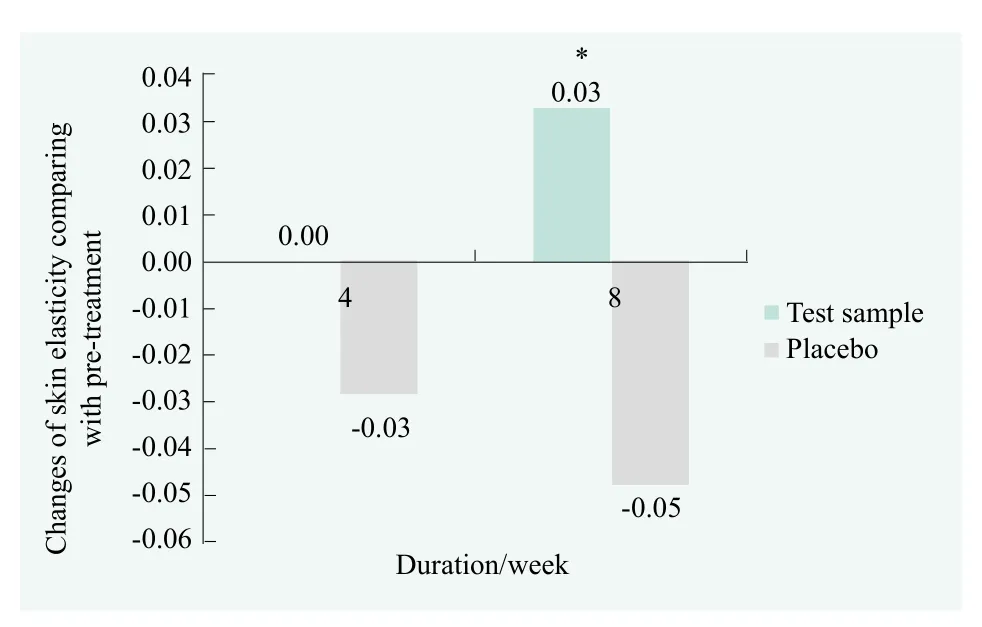
Figure 1b. Changes of skin elasticity R2 value (*p<0.05)
Skin gloss
Figures 2a and 2b present the measurement value of skin gloss of the cheek at different times. Compared with pretreatment, the skin gloss value and total light rate of the test sample were increased significantly (p<0.05) after 4 and 8 weeks. No significant difference was observed in skin gloss and total light rate of placebo. Results showed that the skin gloss improved significantly, and the effect is relatively long-lasting and stable.
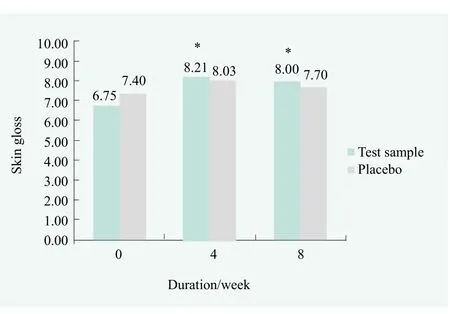
Figure 2a. Skin gloss (*p<0.05)
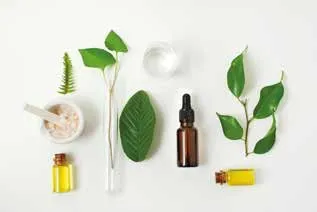
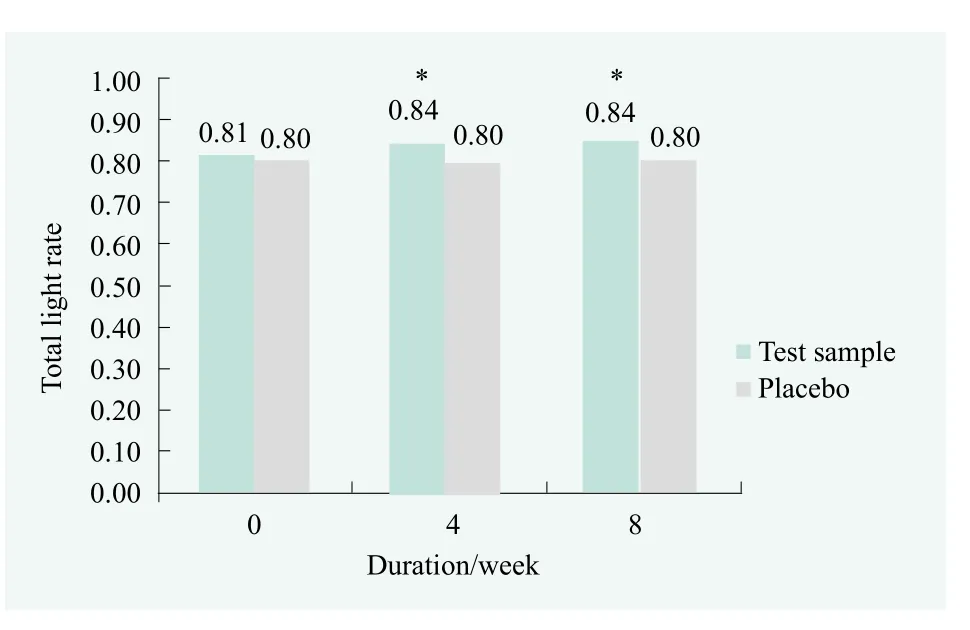
Figure 2b. Total light rate (*p<0.05)
Figures 2c and 2d present the changes in skin gloss value and total light rate of the cheek at different times. A significant difference in skin gloss between the test sample and the placebo was observed after 8 weeks (p<0.05), but no significant difference in total light rate was observed.The value of the test sample increased relative to that of the placebo in both cases, showing that the test sample improved skin gloss.
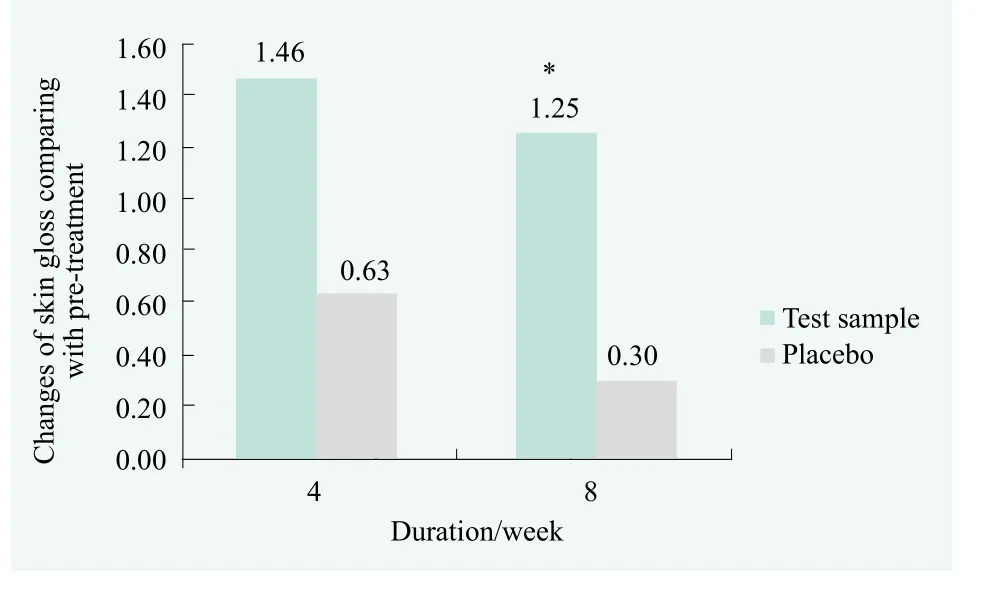
Figure 2c. Changes in skin gloss (*p<0.05)
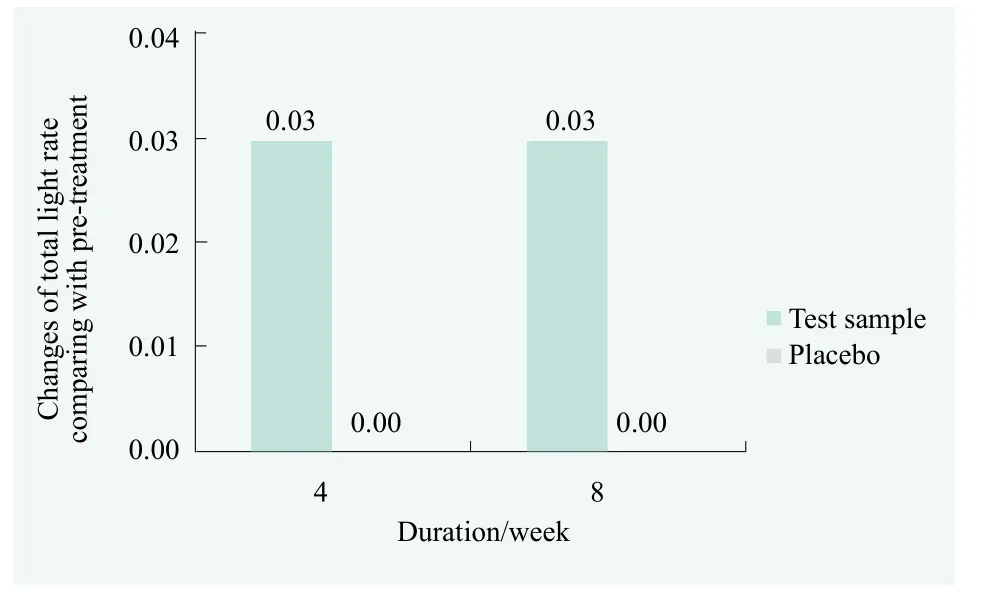
Figure 2d. Changes in total light rate
Skin wrinkle

Figure 3a presents the measurement value of skin wrinkle Sa of the cheek at different times. The SA value of the test sample decreased significantly (p<0.05).Meanwhile, the Sa value of the placebo increased but had no significant change after 4 and 8 weeks. The results showed that the skin wrinkle considerably improved after 4 weeks, and the effect was long-lasting and stable.
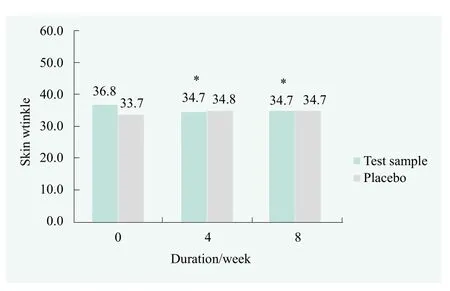
Figure 3a. Skin wrinkle Sa value (*p<0.05)
Figure 3b presents the changes value of skin wrinkle Sa of the cheek at different times. A significant difference in Sa between the placebo and the test sample was observed after 4 and 8 weeks of application (p<0.05). The decrease in the value of the test sample was greater than that of the placebo, indicating that the test sample can improve skin wrinkle, and the effect is relatively long-lasting and stable.
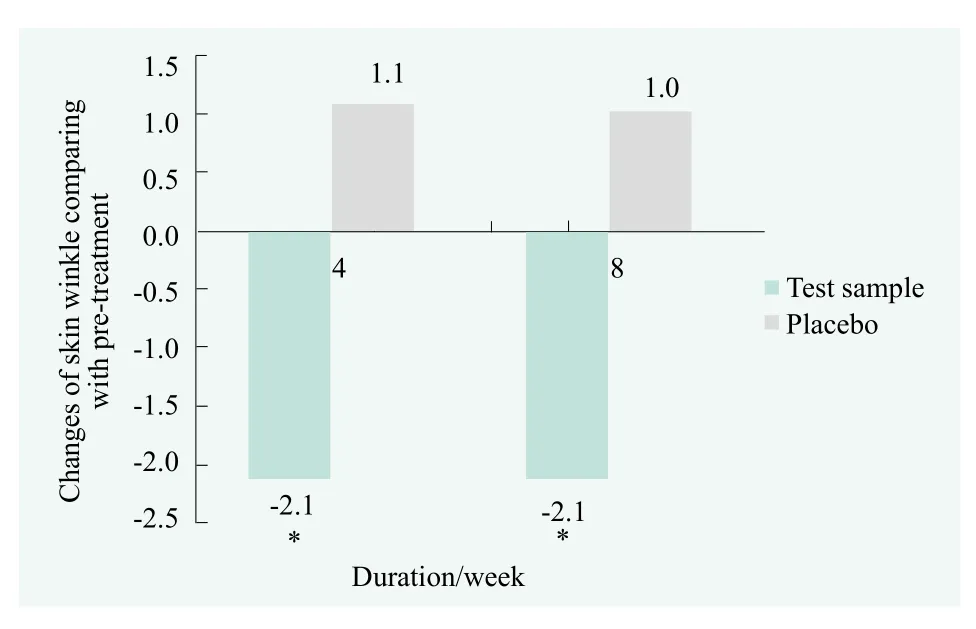
Figure 3b. Changes of skin wrinkle Sa value (*p<0.05)
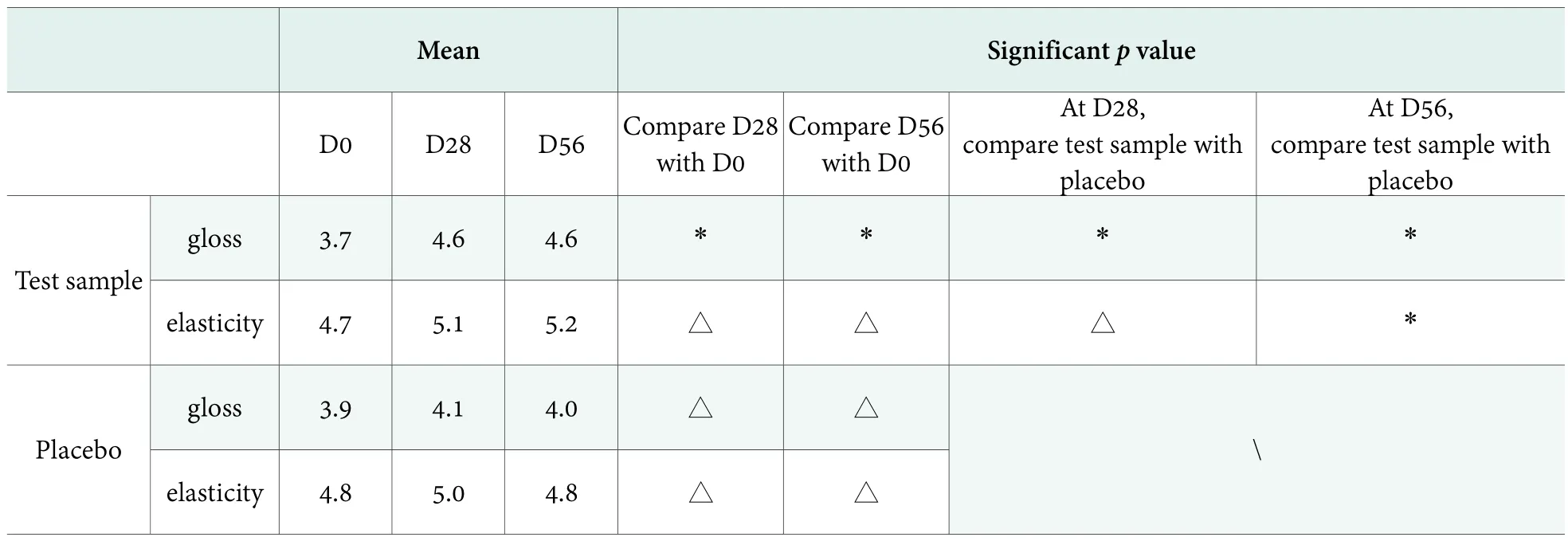
Table 1. Clinical evaluation results (efficiency)
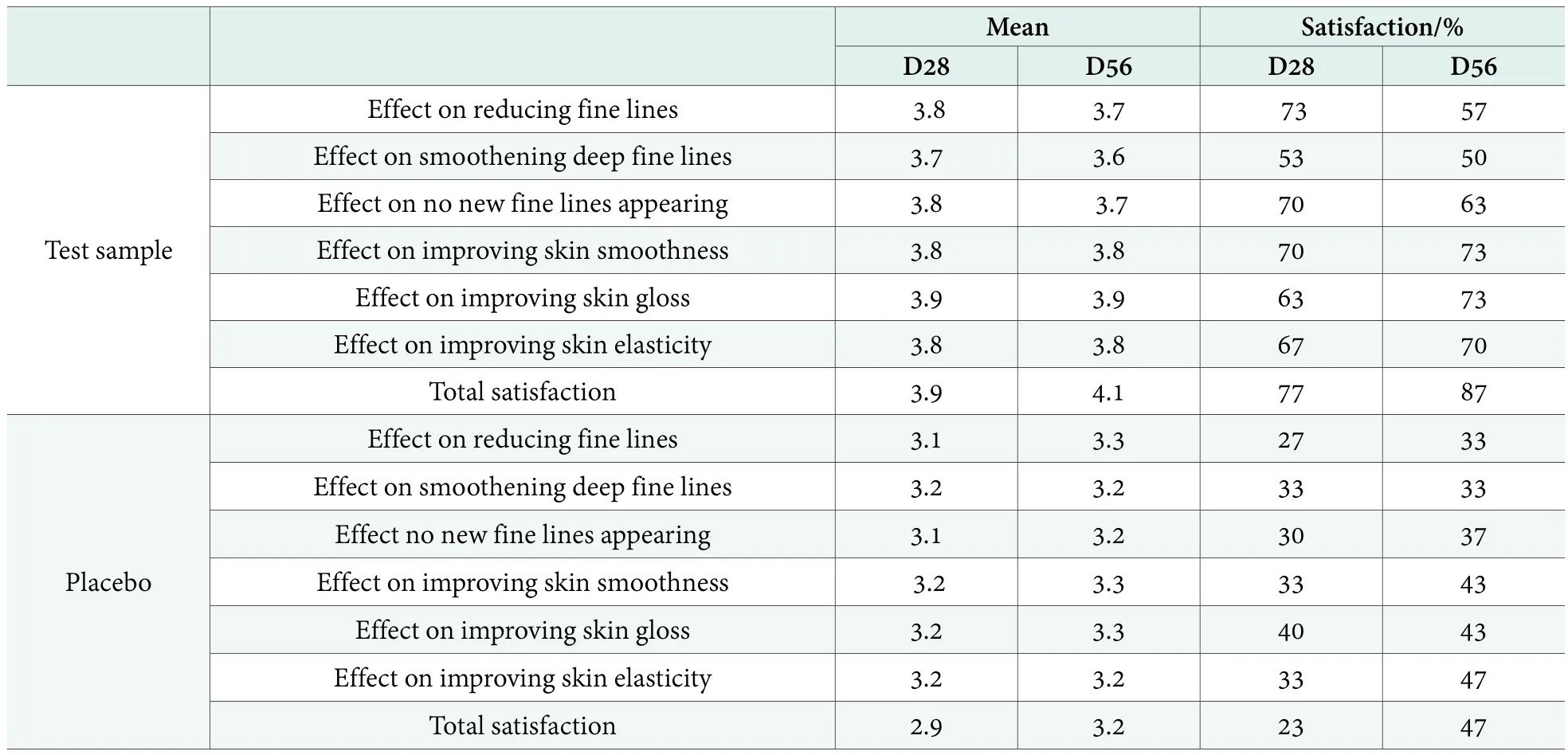
Table 2. Result of self-assessment
Clinical evaluation
No subject had adverse skin reactions during the test.After 8 weeks, the erythema, edema, decrustation, rash,tightness, pruritus, and stabbing pain scores were all 0,showing that the test sample is safe to use.
As shown in Table 1, the score of skin gloss greatly increased, and the score of skin elasticity decreased. No significant difference was observed in the test sample after applying the ginseng root extract and L-carnosine cream for 8 weeks. Significant changes between the placebo and test samples with regard to skin gloss and skin elasticity scores were observed after an 8-week application. The increase of the skin gloss and elasticity score of the test sample was more than those of the placebo. The above results showed that the improvement of skin gloss is obvious.
Self-assessment
Table 2 shows a 4.1 total satisfaction score of the subjects in the test sample group (a score of 4 means the patients were satisfied) after applying the ginseng root extract and L-carnosine cream for 8 weeks, and 87% of the test sample group subjects are satisfied with the test sample.
Conclusions
The prominent features of skin aging are wrinkles,loose skin, rough skin, and loss of elasticity. We evaluated the anti-aging effects of a cream containing ginseng root extract and L-carnosine on skin elasticity, gloss, and wrinkles. Skin elasticity, gloss, and wrinkles obviously improved after applying the cream for 8 weeks, according to instrument measurements. Clinical effect assessment results showed no adverse skin reactions on the patients and presented an obvious skin gloss improvement. The self-assessment results showed that 87% of the subjects were satisfied with the test sample. The cream has a certain anti-aging effect. Our results showed that ginseng root extract and L-carnosine have wide applications in cosmetics.
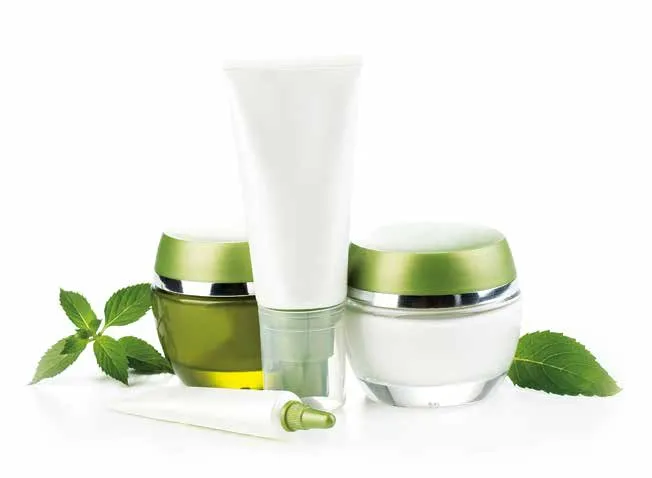
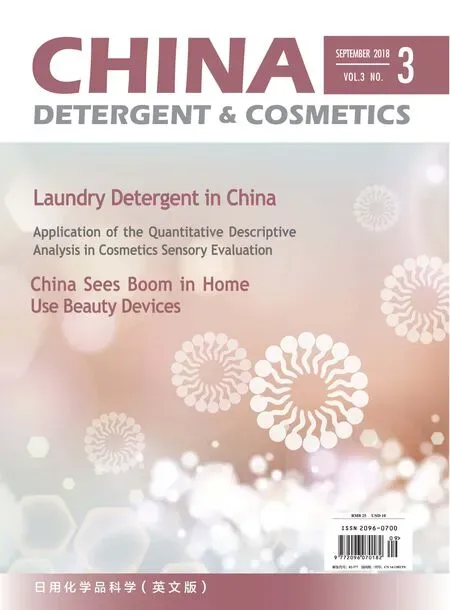 China Detergent & Cosmetics2018年3期
China Detergent & Cosmetics2018年3期
- China Detergent & Cosmetics的其它文章
- Major Industry Events
- Formula Development for Baby Sunscreen Products
- Simultaneous Determination of Six UV-Filters in Cosmetics by HPL C
- Enhanced Solubilization and Stability of Resveratrol in Cosmetic Applications
- Application of the Quantitative Descriptive Analysis in Cosmetics Sensory Evaluation
- New process for the synthesis of a sun-screening agent isooctyl P-methoxy cinnamate
